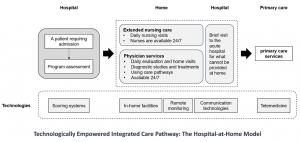Technologically advanced out-of-hospital care in Asia Pacific provide digital solutions
CHINA, January 5, 2024 /EINPresswire.com/ -- Out-of-hospital care surpasses the constraints of traditional in hospital models, transferring healthcare scenarios from within hospital walls to more accessible out-of-hospital settings. The application and promotion of out-of-hospital medical care, especially digital applications, has emerged as a major global trend to enhance medical continuity. Policymakers in the Asia-Pacific region need to explore further to find suitable technical and non-technical paths for their own unique circumstances.
The healthcare systems in the Asia-Pacific region are under the threat of an aging population and the growing demands for medical services. In response to these challenges, out-of-hospital care bolstered by digital medical technologies have been identified as a feasible solution.
In a recent review published in the KeAi journal Informatics and Health, a team of researchers in China provided a timely overview of the current situation of out-of-hospital care in China, Australia, Singapore, China and the United States.
The authors found that out-of-hospital care can circumvent the limitations of traditional in-hospital models, shifting healthcare scenarios from the confines of hospital walls to more readily accessible out-of-hospital settings. Notably, services like out-of-hospital dialysis, cardiovascular and glucose monitoring, and home-based rehabilitation systems can significantly benefit patients managing various chronic conditions. Additionally, during the COVID-19 pandemic, internet-based medical services, including teleconsultation and online prescribing, played a crucial role in delivering timely care to patients with asymptomatic and mild infections within the safety of their homes.
The authors suggested that the efforts are needed to remove barriers on both technical and non-technical challenges in areas like qualification of healthcare professionals, patient and technical equipment qualification, technology and device solutions, recognition of healthcare workers’ labor value, reimbursement coverage, as well as homecare of supply chain.
“Compared to conventional healthcare, out-of-hospital care services offer a more flexible, convenient, and personalized healthcare option with higher accessibility, stronger real-time responsiveness and better continuity,” says You Wu, senior and co-corresponding author of the study. “As the demand for medical services continues to rise, out-of-hospital care is gradually becoming an important direction in the delivery of healthcare.”
“Moving forward, we need to further integrate technologies and the health system and navigate multi-stakeholder collaboration in out-of-hospital care,” adds Wu.
DOI
10.1016/j.infoh.2023.10.002
Original Source URL
https://doi.org/10.1016/j.infoh.2023.10.002
Funding information
This research did not receive any specific grant from funding agencies in the public, commercial, or not-for-profit sectors.
Lucy Wang
BioDesign Research
email us here
Legal Disclaimer:
EIN Presswire provides this news content "as is" without warranty of any kind. We do not accept any responsibility or liability for the accuracy, content, images, videos, licenses, completeness, legality, or reliability of the information contained in this article. If you have any complaints or copyright issues related to this article, kindly contact the author above.

